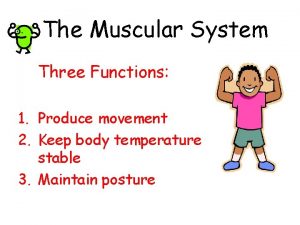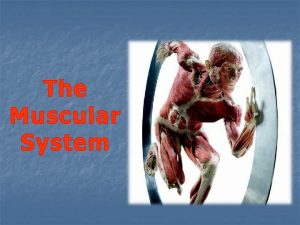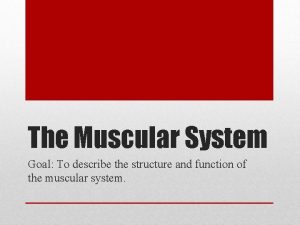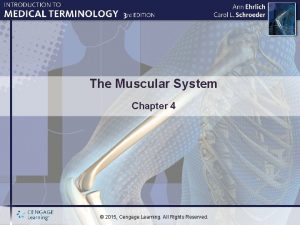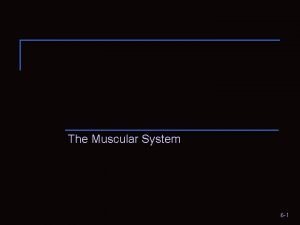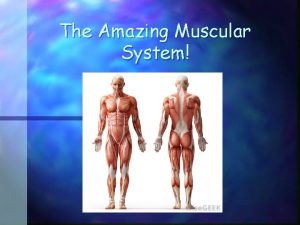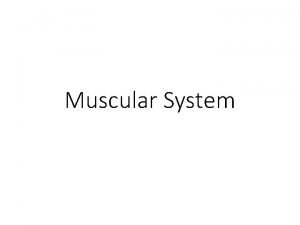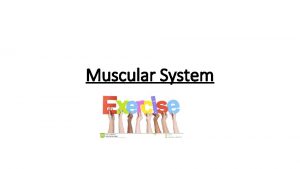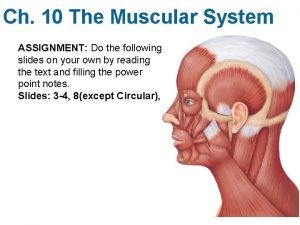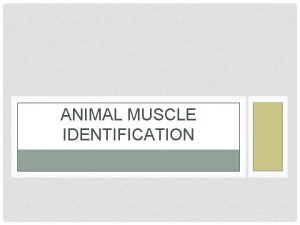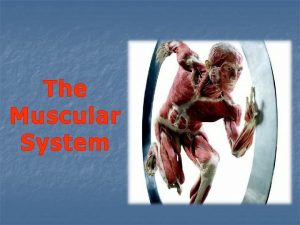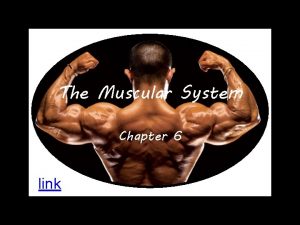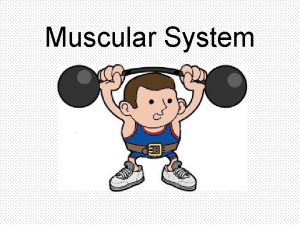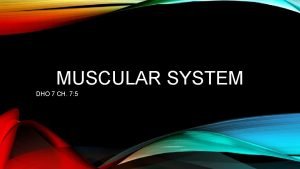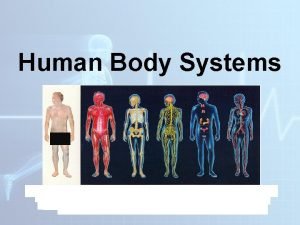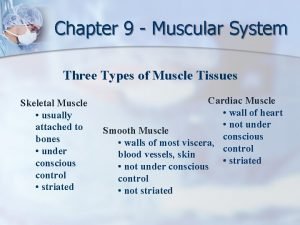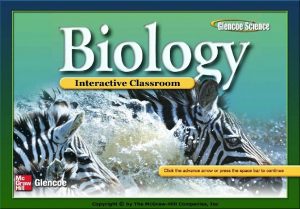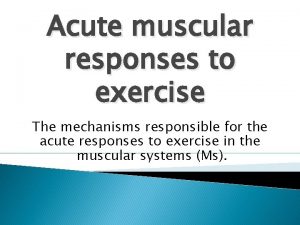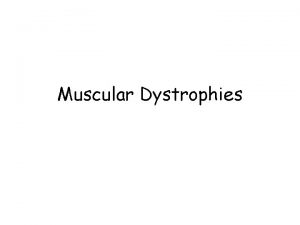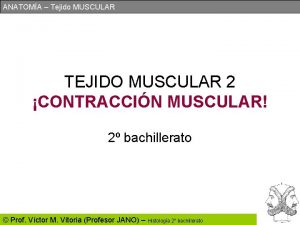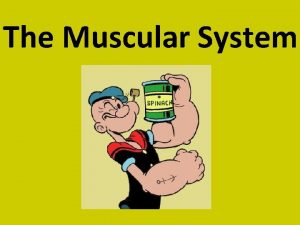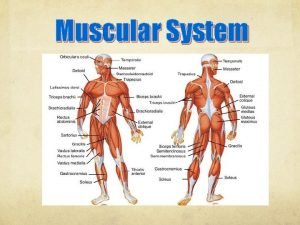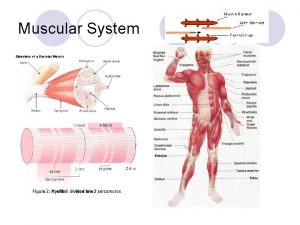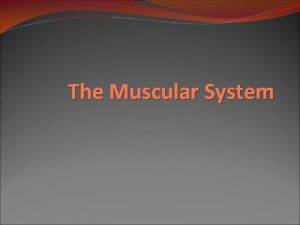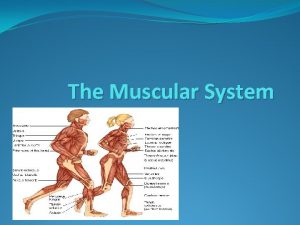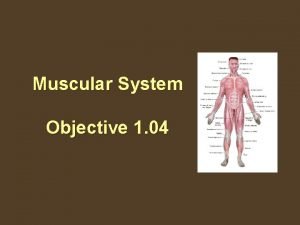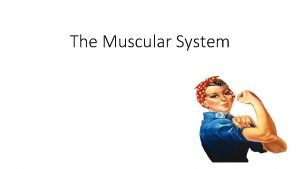The Muscular System FQ What is the hierarchal





















- Slides: 21

The Muscular System • FQ: What is the hierarchal structure of a muscle cell from the tiniest fiber to the largest muscle mass? • ET: Grab a copy of the article from the front of the room? Read and highlight important information from the article

The Muscular System • ET: Wh at are the four majo r roles of muscle the body tissue in ? Use book • Focus Questions 1. FQ: What are the following: endomysium, perimysium, epimysium, tendon, and aponeurosis? • Coloring Sheet • POGIL

The Function of Muscles • Four important roles for the body: 1. 2. 3. 4. Produce movement Maintain posture Stabilize joints Generate Heat

Review of Muscle Tissue Types • All muscle cells are elongated, thus we call them fibers • All muscle cells can contract • Myo/Mys (muscle) • Sarco (flesh)

e l c s u M Skeletal • Connects muscle to bone • Appears striped (striated) • Voluntary • May contract rapidly, and forcefully but tires easily • Structure 1. Endomysium 2. Perimysium 3. epimysium

Smooth Muscle • No striations • Involuntary, slow and constant contractions • Lines hollow visceral organs – stomach, bladder, intestines • Propels substances along a definite track within the body – food • Double layered Sheet of thin cells running circularly and longitudinally

e l c s u M Cardiac • Heart only • Striated • Slow, constant contractions • Figure-8 shaped bundles that pump blood

Microscopic Anatomy of Skeletal Muscle • Sarcolemma – the plasma membrane • Myofibrils – bundles of myosin (thick) and actin (thin) proteins • Sarcoplasmic reticulum – Store and release calcium for muscle contraction

Muscular System Lesson 2 Skeletal Muscle Activity

Stimulation and Contraction of Muscles c s u m o d • FQ: How ove? m / t c a r t n o c • ET: Review anatomy of a skeletal muscle cell using your coloring sheet.

Nerve Stimulus and Action Potential • The neurotransmitter • Acetylcholine (Ach) is released by Axon terminal. • This makes the membrane of the muscle fiber (sarcolemma) permeable to sodium ions. This rush of positively charged ions creates a concentrations gradient/electrical current called an Action Potential.

Mechanism of Muscle Contraction 1. Ca+ ions cause troponin and tropomyosin (regulatory proteins) on the actin filament to change shape and move out of the way so that myosin can bind to it forming a cross bridge 2. using ATP, the myosin head bends toward the center of the sarcomere pulling actin filament (power stroke) 3. Detachment – ATP binds to the myosin head and weakens the cross bridge bond 4. The energy released by ATP reactivates the myosin for another contraction to occur

Muscular System Lesson 3 Providing Energy for Contraction

How does muscle keep up with all the ATP that they need? • 3 Pathways 1. Direct phosphorylation of ADP by creatine phosphate 2. Aerobic respiration 3. Lactic acid fermentation

Direct phosphorylation of ADP by Creatine Phosphate • Creatine phosphate gives its phosphate to ADP to make ATP • CP stores only last about 20 seconds

Aerobic Respiration • Requires Oxygen • 36 ATP / Glucose • Slow compared to CP

Lactic Acid Fermentation • Does not require oxygen • Quicker than CR (2. 5 x faster) • Uses huge amounts of glucose for not a lot of ATP • Good for 30 to 40 seconds of strenuous exercise • Build up of lactic acid causes muscle fatigue and soreness

2 Types of Muscle Contraction • Isotonic – Normal muscle contraction where the fibers are successful in their sliding motion • Isometric – when the fibers attach but cannot slide, like when you try and lift something too heavy. The muscle cannot contract, even though you are engaging it to lift something

• Continuous partial contraction that cannot be consciously controlled • The nervous system stimulates these fibers in a systematic way all the time so that you can move when you decide to move What is Muscle “TONE”? ?

How Does Exercise Effect Muscles? • Aerobic exercise causes muscles to become flexible with a greater resistance to fatigue – Blood supply to the cell increases – Mitochondria increase in number – Increases overall body cell metabolism – Strengthens bone – Strengthens and enlarges the heart – Improves gas exchange in the lungs

How Does Exercise Effect Muscles? • Resistance training (isometric) causes individual muscle cells to develop more fibers and connective tissue – Increases strength and ability to lift – If you exercise your core you’re a providing stability to your entire body
 Plyometrics disadvantages
Plyometrics disadvantages What do muscles move
What do muscles move Naming muscles
Naming muscles Mascular system function
Mascular system function Chapter 4 the muscular system
Chapter 4 the muscular system Unit 6:5 muscular system
Unit 6:5 muscular system Amazing facts about the muscular system
Amazing facts about the muscular system Muscle in latin language
Muscle in latin language Muscular system label
Muscular system label Chapter 6 the muscular system
Chapter 6 the muscular system Muscular system assignment
Muscular system assignment Sheep muscular system
Sheep muscular system Regions of the body
Regions of the body Whats the function of the muscular system
Whats the function of the muscular system Chapter 6 the muscular system figure 6-12
Chapter 6 the muscular system figure 6-12 Whats muscular system
Whats muscular system Test chapter 7:5 muscular system
Test chapter 7:5 muscular system Chapter 9 muscular system
Chapter 9 muscular system Structures of the muscular system
Structures of the muscular system Site:slidetodoc.com
Site:slidetodoc.com Chapter 32 section 3 the muscular system answer key
Chapter 32 section 3 the muscular system answer key Muscular system response to exercise
Muscular system response to exercise

